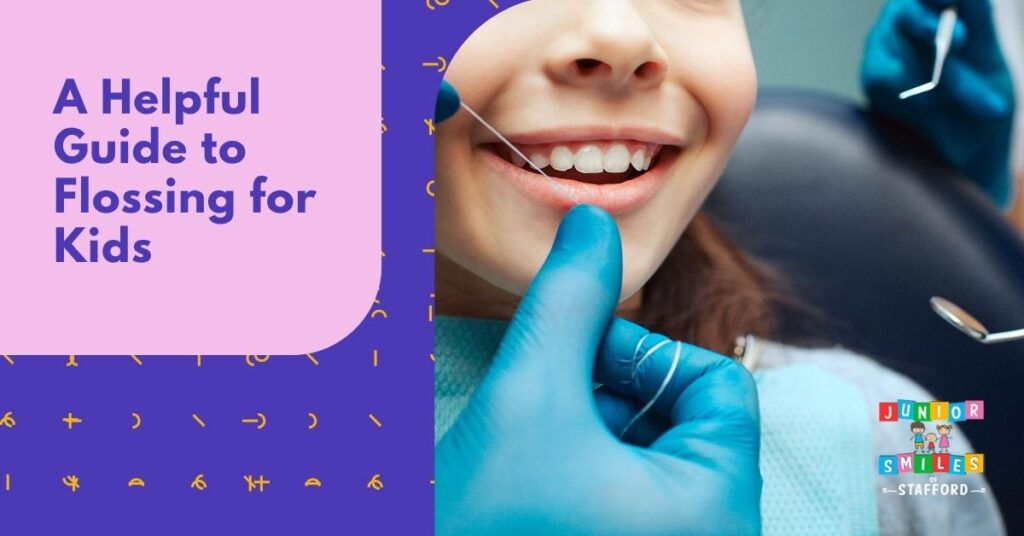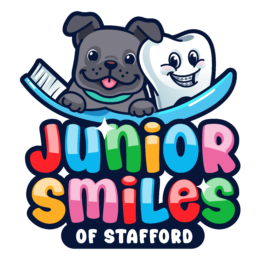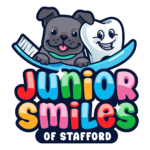A Helpful Guide to Flossing for Kids

As a parent, cleaning and flossing your child’s teeth and gums will be critical for the rest of their lives. Establishing a solid oral hygiene routine early in life will help ensure that your child maintains good oral health habits throughout their adulthood.
When it comes to teaching your child how to floss, pediatric dentists recommend starting at the age of 2 or 3. If you want your child to be ahead of the game when it comes to oral health when they are adults, you must instill regular flossing practices in them while they are young and require supervision and support when they attempt to clean their own teeth on their own.
Why is Flossing Important?
Brushing teeth correctly and consistently is a critical part of oral hygiene that helps in removing the majority of dental plaque. Brushing in a circular motion, covering all surfaces of each tooth, and using a fluoride toothpaste can optimize the cleaning process. Despite thorough brushing, however, it’s impossible to reach every nook and cranny in the mouth, especially the tight spaces between teeth.
The Limits of Brushing in Hard-to-Reach Areas
While brushing plays a significant role in maintaining dental health, it unfortunately doesn’t reach the plaque lurking in the hard-to-reach areas of the mouth. These areas include the tight spaces between teeth, just under the gum line, and along the contours of individual teeth. Over time, the plaque in these inaccessible areas can harden into tartar, which is much more difficult to remove and requires professional dental care.
Consequences of Not Flossing
Failing to remove plaque consistently and thoroughly can lead to tooth decay and gum disease. As plaque accumulates, it can erode the tooth enamel and irritate the gums, potentially leading to gingivitis or periodontitis. Regular dental check-ups and cleanings are essential to complement daily brushing and flossing, ensuring that plaque does not lead to more serious dental issues.
What are the Benefits of Flossing for Kids?
Flossing is about more than just cleaning teeth—it’s a vital defense against oral health issues that can affect children into adulthood. It helps maintain not only the health of their teeth but also contributes to their overall well-being.
Cleaning Between Teeth and Under the Gums
Flossing is an indispensable tool in removing trapped food and debris from between the teeth and under the gums. When your child eats, small pieces of food can get stuck in these spaces, providing a breeding ground for bacteria if not removed. Flossing dislodges this debris, which, if left unchecked, contributes to plaque build-up and can cause discomfort or infection.
Smoothing Down Tooth Surfaces
By smoothing down tooth surfaces through regular flossing, children’s teeth are kept healthier and cleaner. The floss can remove plaque and polish the areas between the teeth, which are often overlooked by toothbrush bristles. This not only contributes to the overall health of the teeth but also makes it more difficult for plaque to adhere to these smooth surfaces in the future.
Managing Bad Breath
Managing bad breath is another advantage of a consistent flossing routine. Bad breath often stems from bacteria build-up within the mouth, particularly in the hard-to-reach areas that a toothbrush can’t clean. By flossing at least once a day, your child can significantly reduce the level of bacteria and hence the occurrence of bad breath, contributing to their overall sense of well-being and confidence.
When Should You Begin Flossing Your Child’s Teeth?
As soon as two teeth meet, you can begin flossing your child’s mouth. It’s okay to brush just the baby teeth when they first come in, as long as they aren’t close to one other. Floss, on the other hand, removes plaque that sticks to teeth that your child’s toothbrush can’t reach between the teeth and under the gums. Maintaining a healthy oral hygiene routine for your child includes brushing and flossing twice a day.
Continue helping your child floss until your child is able to floss thoroughly on their own. Your youngster may not have the physical ability needed to properly floss their teeth if they aren’t old enough to tie their shoelaces.
How To Incorporate Flossing as Part of Your Child’s Oral Healthcare Routine
Teaching your child to floss properly is crucial for their dental health and instills good habits from a young age. Here are steps to incorporate flossing into your child’s oral healthcare routine:
Start Early
Begin introducing flossing when two teeth touch each other. Use soft, flexible floss and demonstrate how it’s done. Explain the importance of flossing in a fun, engaging way to make it an interesting part of their routine.
Choose Child-Friendly Tools
Use flossers designed for children, which are easier to handle and often come in fun colors and shapes. Show your child how to gently slide the floss between their teeth and move it up and down against each tooth.
Make It a Routine
Incorporate flossing into the daily bedtime routine. Flossing after brushing ensures that food particles and plaque between teeth are removed. Praise and encourage your child for flossing, possibly integrating it with a reward system for consistent practice.
Proper Flossing Method for Children
The best dental floss for kids will be the easiest for you to work with, and there are many different kinds of dental floss to choose from. Options range from traditional waxed and unwaxed floss to flavored varieties designed to appeal to children. To make things a little bit simpler, we usually suggest using a mild floss or a kids’ dental floss pick, which can be more fun and engaging for the child to use.
Trying alternate positions can make the flossing experience more comfortable for both you and your child, especially for toddlers and little children who don’t like flossing. Sit behind your child and have them look up to create a stable and accessible flossing environment. Rest their head on your shoulder or upper arm and gently drawback their cheek and lips to look, which helps in providing a clear view and better access to their teeth.
Dental Flossing FAQs
Do Kids Need Special Floss?
Kids don’t necessarily need special floss, but child-friendly flossers can be beneficial. These are easier for small hands to handle and often come in fun designs that appeal to children. It is important to choose the tool that your child is most comfortable with and encourages regular use.
Is Dental Floss Good for Kids?
Yes, dental floss is good for kids. It’s essential for removing plaque and food particles between teeth where a toothbrush can’t reach, helping prevent cavities and gum disease.
Contact Junior Smiles of Stafford to Learn More About Proper Flossing for Kids
Flossing is a critical part of children’s oral hygiene, essential for removing plaque from areas a toothbrush can’t reach. At Junior Smiles of Stafford, we specialize in teaching effective flossing techniques for kids, ensuring they maintain healthy teeth and gums as they grow.
Our team at Junior Smiles of Stafford is dedicated to your child’s dental health. We offer personalized advice and demonstrate child-friendly flossing methods to make dental care a positive experience. For expert guidance on flossing for kids and comprehensive pediatric dental services, contact us at Junior Smiles of Stafford.

